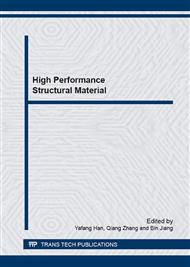[1]
D.V. Thornton, K.H. Meyer, European high temperature materials development for advanced steam turbines, in: R. Viswanathan, J.W. Nutting (Eds. ), Advanced Heat Resistant Steels for Power Generation, IOM Communications Ltd., London, 1999, pp.349-364.
Google Scholar
[2]
J. Bugge, S. Kjar, R. Blum, High-efficiency coal-fired power plants development and perspectives, Energy. 31(2006) 1437-1445.
DOI: 10.1016/j.energy.2005.05.025
Google Scholar
[3]
F. Masuyama, New developments in steels for power generation boilers, in: R. Viswanathan, J.W. Nutting (Eds. ), Advanced Heat Resistant Steels for Power Generation, IOM Communications Ltd., London (1999), pp.33-45.
Google Scholar
[4]
R. Viswanathan, J. Sarver and J.M. Tanzosh, Boiler materials for ultra-supercritical coal power plants-streamside oxidation, J. Mater Eng. Perform. 15(2006) 255-274.
DOI: 10.1361/105994906x108756
Google Scholar
[5]
J. T. Guo, X. K. Du, A superheater tube superalloy GH2984 with excellent properties, Acta Metall. Sin. (In Chinese). 41(2005) 1221-1227.
Google Scholar
[6]
H. Semba, H. Okada, M. Yonemura and M. Igarashi, Creep properties and microstructure of HR6W and Ni-base superalloys for advanced USC boilers, in: Proceeding of 34th MPA-seminar and VGB-symposium on Materials and Components Behavior in Energy and Plant Technology, Stuttgart, Germany, 2008, pp.14-26.
Google Scholar
[7]
D. Allen, J.P. Keustermans, S. Grijbels, V. Bicego, Creep rupture and ductility of as-manufactured and service-aged nickel alloy IN617 materials and welds, Mater. High Temp. 21(2004) 55-60.
DOI: 10.1179/mht.2004.008
Google Scholar
[8]
K. Maile, Qualification of Ni-based Alloys for Advanced Ultra Supercritical Plants, Procedia Eng. 55 (2013), 214-220.
DOI: 10.1016/j.proeng.2013.03.245
Google Scholar
[9]
T. Tokairin, KV. Dahl, H.K. Danielsen, H.B. Grumsen, T. Sato, J. Hald, Investigation on long-term creep ruoture properties and microstructure stability of Fe-Ni based alloy Ni-23Cr-7W at 700 oC, Mater. Sci. Eng. A. 565(2013) 285-291.
DOI: 10.1016/j.msea.2012.12.019
Google Scholar
[10]
T.T. Wang, C.S. Wang, J.T. Guo and L.Z. Zhou, Stability of microstructure and mechanical properties of GH984G alloy during long-term thermal exposure, Mater. Sci. Forum. 747-748(2013) 647-653.
DOI: 10.4028/www.scientific.net/msf.747-748.647
Google Scholar
[11]
J.E. Ramirez, Evaluation of susceptibility of alloy IN740 HAZ stress-relaxation cracking, Welding J 91(2012) 122-132.
Google Scholar
[12]
L.M. Lifshitz and V.V. Slyozov, The kinetics of precipitation from supersaturated solid solutions, J. Phys. Chem. Solids. 19(1961) 35-50.
DOI: 10.1016/0022-3697(61)90054-3
Google Scholar
[13]
C. Wagner, Theorie der alterung von niederschlagen durch umlosen, Z. Elektrochem. 65(1961) 581-591.
Google Scholar
[14]
J.W. Martin, R.D. Doherty, Stability of microstructure in metallic systems, Cambridge University Press, London, (1976).
Google Scholar
[15]
L. Kloc, On the symmetry of denuded zones in diffusional creep, Scripta Mater. 35(1996) 539-541.
DOI: 10.1016/1359-6462(96)00176-5
Google Scholar
[16]
R. Maldonado, E. Nembach, The formation of precipitate dree zones and the growth of grain boundary carbides in the nickel-base superalloys Nimonic PE16, Acta Mater. 45(2007) 213-224.
DOI: 10.1016/s1359-6454(96)00139-5
Google Scholar
[17]
K.R. McNee, G.W. Greenwood, H. Jones, The effect of stress orientation on the formation of precipitate free zones during low stress creep, Scripta Mater 46(2002) 437-439.
DOI: 10.1016/s1359-6462(02)00009-x
Google Scholar
[18]
A.K. Jena, M.C. Chaturvedi, The role of alloying elements in the design of nickel-base superalloys, J. Mater. Sci. 19(1984) 3121-3139.
DOI: 10.1007/bf00549796
Google Scholar
[19]
J.T. Guo, J.X. Xu and W.Y. Wan: Acta Metall. Sin. (In Chinese), vol. 16 (1980), p.386.
Google Scholar
[20]
S.Q. Zhao, X.S. Xie, G.D. Smith, S.J. Patel, Microstructure stability and mechanical properties of a new nickel-based superalloy, Mater. Sci. Eng. A. 355(2003) 96-105.
Google Scholar
[21]
C.P. Sullivan and M.J. Donachie: Metal Eng. Quart, vol. 11(1971), p.1.
Google Scholar
[22]
Q.Y. Huang, H.K. Li, Superalloys, Metallurgy Press, Beijing, (1999).
Google Scholar
[23]
F. Schubert, Temperature and time dependent transformation: application to heat treatment of high temperature alloys, in: V. Guttmann (Eds. ), Phase Stability in High Temperature Alloys, Applied Science Publishers, London, 1981, pp.119-149.
Google Scholar


